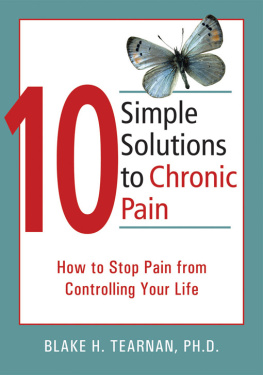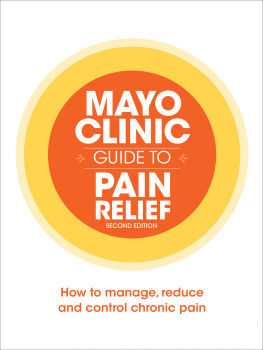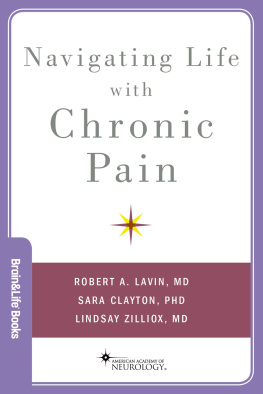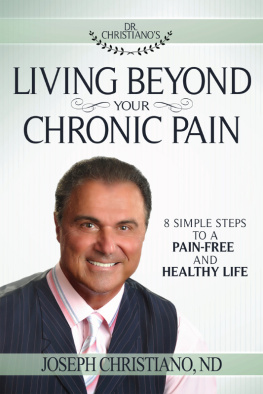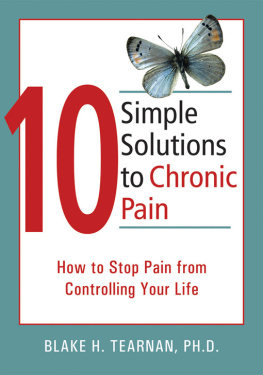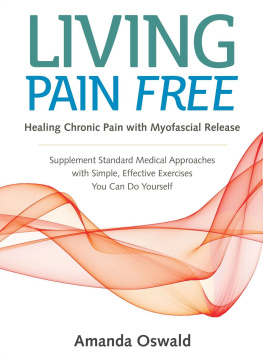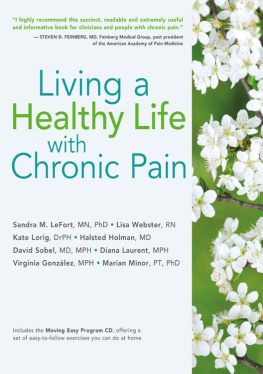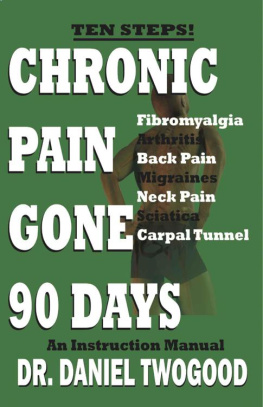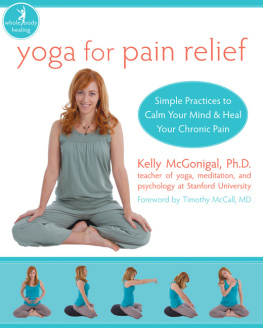I would like to thank the many people who supported me in writing this book. First, and foremost, thanks to my wife, Olivia, for reading the various drafts of the manuscript and giving me invaluable feedback. This thanks also extends to my daughters, Audrey and Vanessa, for reading some of the chapters and putting up with me in my long hours of isolation. I would also like to thank Donna Alexander of St. Marys Hospital in Reno for her invaluable assistance in gathering important research papers for my review. Thanks also to my transcriptionist, Janis Lamers, for deciphering my garbled dictation. My gratitude also to Jess OBrien at New Harbinger Publications for his patience and to the various editors at New Harbinger Publications for their careful attention to detail and guidance in the writing. I am also grateful to my colleagues at Washoe Medical Center for their professional collaboration, including Steve Berman, MD, Ken Pitman, MD, Andrew Wesley, MD, Steve Igaz, MA, Cathy Kline, MA, and P. J. Juhrend, MA. Finally, a special thanks to Dr. William Tao for his friendship and support.
Afterword
Many of the changes that will help you better manage and cope with your chronic pain will need to be practiced for a long time. This isnt an easy task, but it isnt impossible. Youve learned the skills, and now its time to practice what youve learned. You may need to reread some or all of the chapters from time to time to refresh your memory and deepen your understanding of the material in this book. Using the behavior change strategies discussed in chapter 2, develop a daily game plan and stick with it. Practice until youre comfortable and confident with your daily routine, making adjustments as necessary to fit your needs. Do whatever is necessary to make things work and to keep yourself moving forward.
Expect to stumble at times. If you dont, you arent taking the risks necessary to succeed in the long term. Learn to anticipate likely problems as you journey forward. How will you handle future flare-ups? What if you feel overwhelmed with problems again? How would you work your way through them? When might you need help, and where will you turn to find it? If you lose interest in practicing your daily routine, how will you stay motivated about following through on your program?
Make it a habit to periodically take the BAPSI assessment in chapter 4. Are you satisfied with your current levels of functioning and mood? What areas do you need to focus on so you can maintain the gains youve made? Are there other goals youd like to work on?
Congratulations on finishing the book. I know you still have work to do and that there are things you didnt accomplish to the degree you wanted, but this is to be expected. Youll learn to better apply the skills in this book with time and effort. However, for now, pat yourself on the back and be assured that you have the basic tools to move forward with your life despite your paina life of hope and promise.
Blake H. Tearnan, Ph.D., is director of behavioral medicine for the Functional Restoration Program at Washoe Medical Center Rehabilitation Hospital in Reno, and clinical director for the Southern Nevada Functional Restoration Program in Las Vegas, NV. He graduated from the University of Georgias Clinical Psychology Program with a specialization in clinical and medical psychology. He has held positions at the University of Wisconsin, University of Nevada Medical School, and the Veterans Affairs Medical Center in Reno, NV. He was also clinical coordinator at the Sierra Pain Institute and director of the Sonora Pain Center. Tearnan is a founding partner of the Reno Spine Center, president of HealthNetSolutions.com, and a consultant to various groups including Innovative Health Solutions and the American Academy of Pain Management, where he is on the board of advisors.
Tearnan has published widely in the areas of medical rehabilitation, health, pain, and anxiety disorders. He is the author of numerous psychometric instruments on general health, pain, and disability including the Pain Disability Report, Behavioral Assessment of Pain, and the Life Assessment Questionnaire.
Understanding Pain and Suffering
Learning more about pain, and specifically about the interrelationship between pain, suffering, and disability, will allow you to better understand your own situation. This is an important first step in learning how to manage your pain and improve your quality of life. Its also the foundation for understanding and implementing all of the solutions in the chapters that follow.
Pain arises from actual or potential damage to the body, motivating people to take action to avoid harm or seek recuperation (Asmundson 1999). Cognitive and emotional factors come into play as the pain information enters the central nervous system. How a person interprets and responds to pain is influenced by the expected threat associated with the pain.
Defining Pain
Pain is difficult to define since its something we cant touch or see. Its a subjective experience, and its also basic to our survival. As youll learn, pain is much more than the feeling you get when you stub your toe or burn yourself on a hot stove.
How we define pain is important, since it helps to make this complex experience more understandable, leading to better ways of approaching solutions to the problem of pain. In 1982, pain expert John Loeser proposed that pain consists of four dimensions: nociception, pain, suffering, and pain behavior. Nociception is a complicated-sounding word, but it simply refers to potential tissue damage and injury that excites nerve endings. Think of nociception as the underlying physical mechanism that initiates the signal of pain. The second dimension, pain, is the sensation experienced as a consequence of nociception. Subjectively, you might describe your pain as achy, tender, sore, sharp, stabbing, or burning. Suffering is the negative emotion generated by pain and problems associated with pain, such as stress and various losses. Finally, pain behavior refers to any behavior you exhibit in association with the presence of pain, such as facial expressions, speech patterns, taking medication, asking others for help, and limiting your activities.
Loesers view of pain is a useful starting point. However, the components need to be understood in a broader context, especially with regard to how you interpret and react to pain, and how your pain is affected by various social influences and other environmental factors. In other words, pain is not simply a well-defined response to a physical stimulus registered in the central nervous system and resulting in an uncomfortable sensation. As nociceptive stimulation enters the spinal cord and brain, the signal doesnt travel to a specific pain center. Pain information travels to many areas of the brain involved with interpretation, judgment, and emotions. This is where matters get complex, since distraction, past experiences with pain, fears attributed to pain, perception of coping strength, social support, and a whole host of other factors determine in a puzzling way how pain is experienced and how you respond to it.
Historically, pain has been thought of in purely mechanistic terms. The analogy often used for pain is a rope and a bella jerk of the rope causes the pain bell to ring. However, this is too simplistic. For example, it doesnt account for why people who are anxious experience more intense pain. The experience of pain is affected by a variety of psychological, social, and cultural influences, calling into question the notion that pain can be adequately explained by a wired, mechanistic process.
Acute Versus Chronic Pain
Acute pain refers to pain that lasts less than three months. Acute pain serves a useful purpose, helping motivate us to take action to protect ourselves. Tissue damage, swelling, and inflammation are characteristic of new-onset pain. Normally, but not always, the extent of the damage determines the intensity of pain experienced. Acute pain is generally responsive to treatment, such as medications. Emotionally, acute pain can trigger feelings of anxiety, which is usually a good thing because anxiety helps motivate us to take action, such as seeking help, monitoring the status of the injury, and being careful to avoid further injury.

